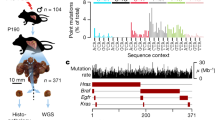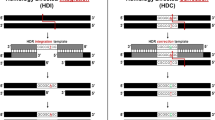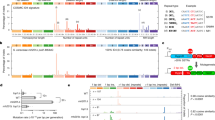Abstract
An important step in carcinogenesis is thought to be the initial attack of the DNA molecule by a so-called ultimate carcinogen. More than 90% of the carcinogens tested have been found to be mutagens in bacterial systems1. The covalent binding of the ultimate carcinogen to the DNA bases or phosphate groups creates a premutational lesion that in vivo is processed by the repair, replication and recombination enzymes, and eventually may be converted into a mutation. Being interested in the way that an initial premutational event is converted into a stable heritable mutation, we have sequenced stable mutations in a gene that has formed covalent adducts in vitro with N-acetoxy-N-2-acetylaminofluorene (N-AcO-AAF, a model for the ultimate metabolite of the rat liver carcinogen 2-acetylaminofluorene AAF). We show here that the mutations are mainly frameshifts involving G · C base pairs, and that certain base pairs (hotspots) are affected at relatively high frequences. These results fit a model in which N-AcO-AAF-modified guanine acts as a non-coding base that during replication results in deletion of the modified residue.
This is a preview of subscription content, access via your institution
Access options
Subscribe to this journal
Receive 51 print issues and online access
$199.00 per year
only $3.90 per issue
Buy this article
- Purchase on Springer Link
- Instant access to full article PDF
Prices may be subject to local taxes which are calculated during checkout
Similar content being viewed by others
References
McCann, J., Choi, E., Yamasaki, E. & Ames, B. N. Proc. natn. Acad. Sci. U.S.A. 72, 5135–5139 (1975).
Ames, B. N., Gurney, E. G., Miller, J. A. & Bartsch, H. Proc. natn. Acad. Sci. U.S.A. 70, 782–786 (1973).
Santella, R. M., Fuchs, R. P. P. & Grunberger, D. Mutat. Res. 67, 85–87 (1979).
Landolph, J. R. & Heidelberger, C. Proc. natn. Acad. Sci. U.S.A. 76, 930–934 (1979).
Kriek, E., Miller, H. A., Juhl, V. & Miller, E. C. Biochemistry 6, 177–182 (1967).
Westra, J. G., Kriek, E. & Hittenhausen, H. Chem.-biol. Interact. 15, 149–164 (1976).
Fuchs, R. & Daune, M. Biochemistry 11, 2659–2666 (1972).
Fuchs, R. P. P. & Daune, M. P. Biochemistry 13, 4435–4440 (1974).
Fuchs, R. P. P. Nature 257, 151–152 (1975).
Fuchs, R. P. P., Lefèvre, J. F., Pouyet, J. & Daune, M. P. Biochemistry 15, 3347–3351 (1976).
Grunberger, D. & Weinstein, I. B. in Chemical Carcinogens and DNA Vol. 2 (ed. Grover, P.) 59–94 (CRC, Florida, 1979).
Ullrich, A. et al. Science 196, 1313–1319 (1977).
Radman, M. Photochem. Photobiol 32, 823–830 (1980).
Maxam, A. M. & Gilbert, W. Proc. natn. Acad. Sci. U.S.A. 74, 560–564 (1977).
Sutcliffe, J. G. Cold Spring Harb. Symp. quant. Biol. 43, 77–90 (1979).
Isono, K. & Yourno, J. Proc. natn. Acad. Sci. U.S.A. 71, 1612–1617 (1974).
Moore, P. D., Bose, K. K., Rabkin, S. D. & Strauss, B. S. Proc. natn. Acad. Sci. U.S.A. 78, 110–114 (1981).
Howard-Flanders, P., Boyce, R. P. & Theriot, L. Genetics 53, 1119–1136 (1966).
Lefèvre, J. F., Fuchs, R. P. P. & Daune, M. P. Biochemistry 17, 2561–2567 (1978).
de Murcia, G. et al. Proc. natn. Acad. Sci. U.S.A. 76, 6076–6080 (1979).
Cohen, S. N., Chang, A. C. Y. & Hsu, L. Proc. natn. Acad. Sci. U.S.A. 69, 2110–2114 (1972).
Clewell, D. B. & Helinski, D. R. Proc. natn. Acad. Sci. U.S.A. 62, 1159–1166 (1969).
Katz, L., Kingsbury, D. K. & Helinski, D. R. J. Bact. 114, 557–591.
Author information
Authors and Affiliations
Rights and permissions
About this article
Cite this article
Fuchs, R., Schwartz, N. & Daune, M. Hot spots of frameshift mutations induced by the ultimate carcinogen N- acetoxy-N-2-acetylaminofluorene. Nature 294, 657–659 (1981). https://doi.org/10.1038/294657a0
Received:
Accepted:
Issue Date:
DOI: https://doi.org/10.1038/294657a0
This article is cited by
-
Artificial intelligence uncovers carcinogenic human metabolites
Nature Chemical Biology (2022)
-
Defining the position of the switches between replicative and bypass DNA polymerases
The EMBO Journal (2004)
-
How DNA lesions are turned into mutations within cells?
Oncogene (2002)
-
Mutational spectrum induced in Saccharomyces cerevisiae by the carcinogen N-2-acetylaminofluorene
Molecular and General Genetics MGG (1994)
-
MucAB but not UmuDC proteins enhance −2 frameshift mutagenesis induced by N-2-acetylaminofluorene at alternating GC sequences
Molecular and General Genetics MGG (1994)
Comments
By submitting a comment you agree to abide by our Terms and Community Guidelines. If you find something abusive or that does not comply with our terms or guidelines please flag it as inappropriate.



